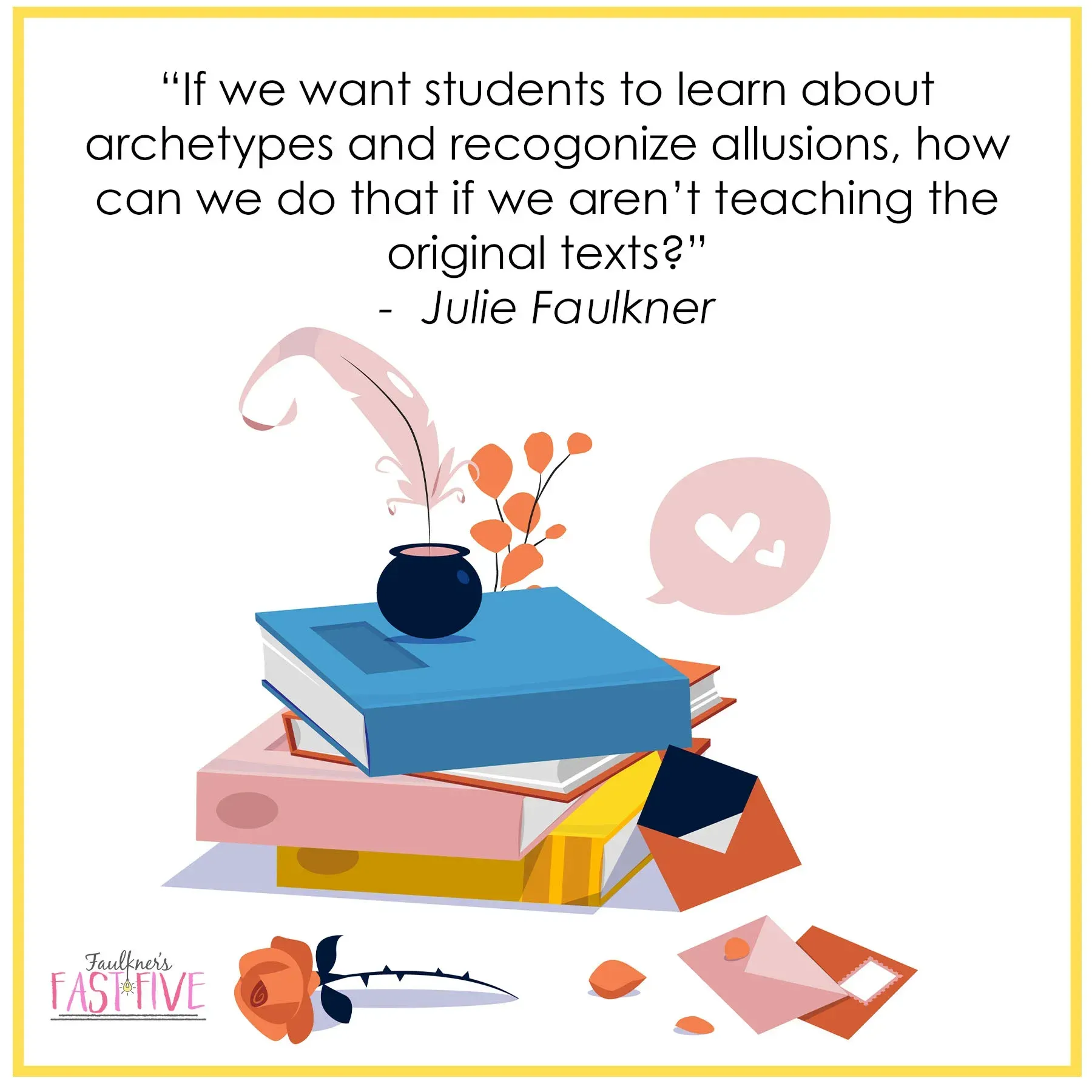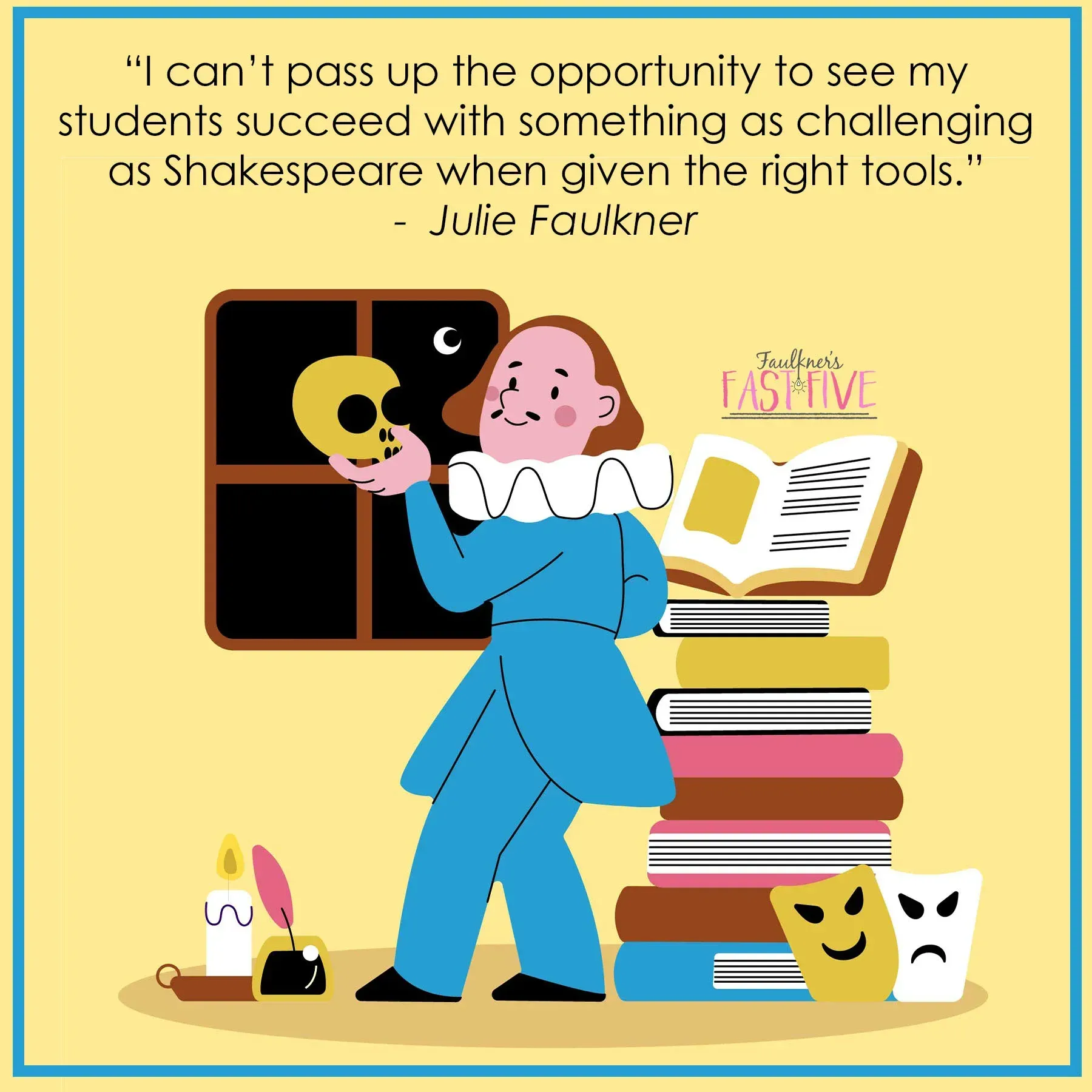Everything You Need to Know About
Teaching Shakespeare with a Translation
The debate surrounding whether or not to teach Shakespeare continues to grow in discussions of modern curriculum. I don’t wish to engage in that debate. My stance? Teach Shakespeare. Even in that camp – those brave English teachers teaching Shakespeare – there is a different debate: that debate is whether or not to use translated supplements of the plays. In that debate, I would like to participate and make my case for Shakespeare Made Easy, or other similar publications. Some people may feel using supplemental tools like this to teach Shakespeare may be taboo or unacceptable, but I want to share why and how I use this tool successfully so you might, too, go boldly into your next Shakespeare unit! (BTW: I’m not paid to promote any line of books. I’m just sharing a classroom success story of teaching Shakespeare with a translation.)
ANALYZING THE PURPOSE OF TEACHING SHAKESPEARE
When I teach Shakespeare – or anything for that matter – I ask myself “What do I want my students to really learn?” If you answer, “I want them to learn how to read archaic language” or “I need students to be exposed to Early Modern English” then you’ll need to stick with his original manuscript. If your goals are somewhat different, then it might be time to consider a side-by-side translation. A side-by-side presents both the original and modern text. I want students to experience Shakespeare for many reasons, but the shortlist includes exposure to his craft, themes, plot, character development, skilled use of irony, creation of new words, idioms, etc. When I read Macbeth, for example, we read every word in class. Yes! Every word. Usually, I have an audio, and we even do some reading and acting. The audio I use – it’s the original Shakespeare. I’m not watering anything down. In fact, their reading even takes on another level when students can see the original and modern, and then compare and contrast those two.
ELIMINATE FEAR OF SHAKESPEARE AND BUILD CONFIDENCE INSTEAD
In everything we teach, we should plan ways to differentiate. If I can give students a tool – that I don’t even have to create – that takes away fear and builds confidence for reading, of course, I want to use that. When I taught Macbeth to my regular-track seniors last semester, they were truly engaged. In addition to the supplemental translation, I looked for every way possible to make text-self and text-world connections. My Macbeth unit is full of those goodies. After it was all over, they told me that was the first Shakespeare play they’d ever read. They’d seen movies of some of his other plays, but never had they read the entire thing. We celebrated their accomplishment with a round of applause and a pat on the back. They were genuinely proud of themselves for sticking with it, and honestly, not once did I have to beg them to read or go back into the text to look for answers. What a great feeling to experience that with them.
ENGAGING WITH SHAKESPEARE
I haven’t always had access to a No Fear Shakespeare or Shakespeare Made Easy type of supplement, so my experience here does come from having done it both ways. (Though nowadays there are many copies online.) Now that I use a side-by-side translation every time I teach Shakespeare – even with honor students – and I see so much more engagement. Before, as we would read in class when I stopped to ask questions or dig a little more deeply, students were generally clueless. They weren’t getting the plot, not to mention his puns and other subtleties. With a translation, reading, and discussions are so much more worthwhile because students aren’t confused or frustrated. I like a productive struggle, but without some help, Shakespeare is often just a struggle. They aren’t asking me “What does that mean?” or complaining they don’t understand any of the lines. They can actually answer my questions AND offer insight. Sometimes when I pause, I’ll ask the question, and I notice them going back to read the translation to see if they can figure it out. Yes – I did say “going back to read” the text. My students aren’t feeling shut down but rather empowered. That in and of itself is an amazing success story.
ACCOUNTABILITY FOR ORIGINAL SHAKESPEARE LANGUAGE AND TEXT
In anything students write about the text, I require them to cite from the original. Using a side-by-side doesn’t mean throwing the original language away. It doesn’t mean replacing the original, either. It’s genuinely a tool I pick to give students more insight into what they are reading.
TO USE OR NOT TO USE A TRANSLATION WHEN TEACHING SHAKESPEARE
It’s simple for me: I’d rather read a side-by-side of Shakespeare than no Shakespeare at all. I’ve read articles where people advocate not to teach Shakespeare at all; I wonder if that’s because they think it’s too old or out-of-date. Tell that to Gatsby, Twilight, or any other modern star-crossed lovers story. Tell that to Mean Girls and Macbeth — or any other text whose main character errs on the side of ambition for that matter. If we want to teach students about archetypes and allusions, how do we do that if we aren’t teaching them the originals? Yes, other complex texts have similar skills for learning and related themes. But why eliminate the traditional ones? How about we keep the classics and pair them with something modern? Take a look at a quick video where I explain how I use Mean Girls with Macbeth.
I’m not forcing students to read Shakespeare, as I’ve seen people say. I’m offering them new opportunities. Many of my rural students may never pick up a copy of Shakespeare again, but that wasn’t my goal anyway. Call me a sucker for tradition, but I can’t pass up the opportunity to see my students succeed with something as challenging as Shakespeare when given the right tools. If you visit my classroom, rest assured that you’ll find a stack of Shakespeare Made Easy books ready to go.
Love this content?
Sign up for my email newsletter with more tips, ideas, success stories, and freebies!


















